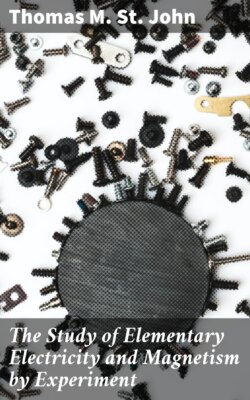Читать книгу The Study of Elementary Electricity and Magnetism by Experiment - Thomas M. St. John - Страница 6
CHAPTER III.
INDUCED MAGNETISM.
ОглавлениеFig. 11.
EXPERIMENT 24. To find whether we can magnetize a piece of iron without touching it with a magnet.
Apparatus. Horseshoe magnet, H M; iron filings, I F (Fig. 11).
52. Directions. (A) Hold the armature of the magnet in a vertical position (Fig. 11), its lower end being directly in a little pile of iron filings.
(B) Bring the N pole of H M near the upper end of A, but do not let them touch each other.
(C) Keeping A and the pole of H M the same distance apart, lift them. Do any filings cling to A?
(D) Without moving or jarring A, take H M away from it and note result upon the filings.
53. Temporary Magnetism; Induced Magnetism. The armature, A, was induced to become a magnet without even touching H M. Its magnetism was temporary, however, as the filings dropped as soon as the inductive action of H M was removed. A small amount of residual magnetism (44) remained in A. Soft iron is exceedingly valuable, because it has very little retentivity (44), and because it can be easily magnetized by induction. The armature was made of soft iron. It had induced magnetism. It was a temporary magnet.
EXPERIMENT 25. To find whether a piece of steel can be permanently magnetized by induction.
Apparatus. An unmagnetized sewing-needle; horseshoe magnet, H M; iron filings; sheet of stiff paper.
54. Directions. (A) Test the needle for magnetism.
(B) Place the unmagnetized needle upon the paper, then move H M about immediately under it, so that the needle will be attracted.
(C) Test the needle again for permanent magnetism.
Fig. 12.
EXPERIMENT 26. To study the inductive action of a magnet upon a piece of soft iron.
Apparatus. Horseshoe magnet, H M; iron filings, I F; a piece of soft iron wire about an inch long, I W (Fig. 12), placed upon the N pole of H M; compass, O C (No. 18), (§ 32).
55 Directions. (A) Test the lower end of I W for magnetism with I F.
(B) Leaving I W upon the N pole of H M, test the pole at the lower end of I W with O C, to determine whether it is N or S.
(C) Jar I W (Exp. 19), then place it upon the S pole of H M, and again test the polarity of the lower end.
56. Polarization; Pole Pieces. The wire, I W (Fig. 12), was acted upon by induction (Exp. 24) and behaved like a magnet. Poles were produced in it, so we say that the wire was polarized. Pieces of iron, placed upon the poles of a magnet, are called pole pieces. It should be noted that the lower end of the wire has a pole like the pole of H M, to which it is attached.
EXPERIMENTS 27–30. To study pole pieces.
Apparatus for Experiments 27–30. Horseshoe magnet, H M; soft iron wires; iron filings, I F.
57. Directions. (A) Suspend two wires, each about an inch long (Fig. 13) from one pole of H M. Do their lower ends attract or repel each other?
Fig. 13.
Fig. 14.
EXPERIMENT 28.
58. Directions. (A) Place the two wires just used so that one shall cling to the N pole of H M, and the other to the S pole of H M (Fig. 14).
(B) Bring the lower ends of the wires near each other. Do they attract or repel each other?
EXPERIMENT 29.
59. Directions. (A) Bend a 2-inch iron wire, as in Fig. 15, and place it upon the poles of H M.
(B) See if its central part, marked X, will strongly attract filings.
Fig. 15.
Fig. 16.
EXPERIMENT 30.
60. Directions. (A) Bend the wire just used a little more, and place its ends upon one pole of H M (Fig. 16).
(B) See if the iron filings and small wires will cling to its central part.
